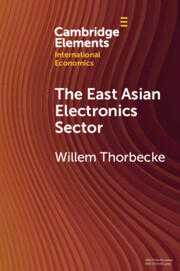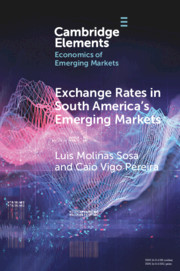41 results
13 - Exchange Rates, Tariffs and Prices in 1930s Britain
-
-
- Book:
- Keynes's <i>Economic Consequences of the Peace</i> after 100 Years
- Published online:
- 14 December 2023
- Print publication:
- 25 January 2024, pp 325-363
-
- Chapter
- Export citation
Do Exchange Rates Influence Voting? Evidence from Elections and Survey Experiments in Democracies
-
- Journal:
- International Organization / Volume 77 / Issue 4 / Fall 2023
- Published online by Cambridge University Press:
- 07 December 2023, pp. 789-823
- Print publication:
- Fall 2023
-
- Article
-
- You have access
- Open access
- HTML
- Export citation
Segregated Economies in an Integrated World: The Gendered Consequences of Exchange Rate Movements in Low- and Middle-Income Countries
-
- Journal:
- International Organization / Volume 77 / Issue 3 / Summer 2023
- Published online by Cambridge University Press:
- 15 September 2023, pp. 668-689
- Print publication:
- Summer 2023
-
- Article
- Export citation

The East Asian Electronics Sector
- The Roles of Exchange Rates, Technology Transfer, and Global Value Chains
-
- Published online:
- 07 February 2023
- Print publication:
- 23 February 2023
-
- Element
- Export citation
Exchange rates and the macroeconomy in an era of global financial crises, with special reference to Australia
-
- Journal:
- The Economic and Labour Relations Review / Volume 24 / Issue 1 / March 2013
- Published online by Cambridge University Press:
- 01 January 2023, pp. 51-63
-
- Article
- Export citation
A note on estimating income inequality across countries using PPP exchange rates
-
- Journal:
- The Economic and Labour Relations Review / Volume 29 / Issue 1 / March 2018
- Published online by Cambridge University Press:
- 01 January 2023, pp. 24-37
-
- Article
- Export citation
The Collapse of the Gold Standard in Africa: Money and Colonialism in the Interwar Period
-
- Journal:
- African Studies Review / Volume 66 / Issue 3 / September 2023
- Published online by Cambridge University Press:
- 20 December 2022, pp. 656-677
-
- Article
-
- You have access
- Open access
- HTML
- Export citation
5 - From Paper to Gold
- from Part II - The Art of Survival
-
- Book:
- Sovereignty without Power
- Published online:
- 27 October 2022
- Print publication:
- 03 November 2022, pp 116-138
-
- Chapter
- Export citation
12 - Are There Any Behavioral Insights for Macroeconomists?
-
- Book:
- Principles of Behavioral Economics
- Published online:
- 18 October 2022
- Print publication:
- 28 July 2022, pp 388-429
-
- Chapter
- Export citation
The Arbitrage Lobby: Theory and Evidence on Dual Exchange Rates
-
- Journal:
- International Organization / Volume 76 / Issue 1 / Winter 2022
- Published online by Cambridge University Press:
- 13 August 2021, pp. 105-125
- Print publication:
- Winter 2022
-
- Article
- Export citation
Domestic Politics, China's Rise, and the Future of the Liberal International Order
-
- Journal:
- International Organization / Volume 75 / Issue 2 / Spring 2021
- Published online by Cambridge University Press:
- 09 February 2021, pp. 635-664
- Print publication:
- Spring 2021
-
- Article
- Export citation
5 - Price Formation and Price Trends in Commodities
-
- Book:
- A Handbook of Primary Commodities in the Global Economy
- Published online:
- 06 November 2020
- Print publication:
- 26 November 2020, pp 91-115
-
- Chapter
- Export citation
6 - The Long Shadow of the Deutschemark
-
- Book:
- Making a Modern Central Bank
- Published online:
- 18 September 2020
- Print publication:
- 17 September 2020, pp 147-188
-
- Chapter
- Export citation
16 - Exchange Rates and Purchasing Power Parity
- from Part III. - International Finance
-
- Book:
- An Introduction to International Economics
- Published online:
- 18 September 2020
- Print publication:
- 27 August 2020, pp 355-375
-
- Chapter
- Export citation
17 - Flexible Exchange Rates
- from Part III. - International Finance
-
- Book:
- An Introduction to International Economics
- Published online:
- 18 September 2020
- Print publication:
- 27 August 2020, pp 376-398
-
- Chapter
- Export citation
18 - Fixed Exchange Rates
- from Part III. - International Finance
-
- Book:
- An Introduction to International Economics
- Published online:
- 18 September 2020
- Print publication:
- 27 August 2020, pp 399-420
-
- Chapter
- Export citation

Exchange Rates in South America's Emerging Markets
-
- Published online:
- 22 June 2020
- Print publication:
- 16 July 2020
-
- Element
- Export citation
5 - Exchange Rates, Capital Flows and the Financial Cycle
-
-
- Book:
- Promoting Global Monetary and Financial Stability
- Published online:
- 10 April 2020
- Print publication:
- 30 April 2020, pp 168-205
-
- Chapter
- Export citation
The Impact of Exchange Rates on French Wine Exports
-
- Journal:
- Journal of Wine Economics / Volume 14 / Issue 1 / February 2019
- Published online by Cambridge University Press:
- 07 May 2019, pp. 71-89
-
- Article
- Export citation
MONETARY POLICY AND EXCHANGE RATES: A BALANCED TWO-COUNTRY COINTEGRATED VAR MODEL APPROACH
-
- Journal:
- Macroeconomic Dynamics / Volume 23 / Issue 5 / July 2019
- Published online by Cambridge University Press:
- 20 September 2017, pp. 1838-1874
-
- Article
- Export citation



